Source: Jennifer Shike, Farm Journal’s Pork, 23 April 2021, photo credit: Genetic Literacy Project
Media reports of African swine fever virus (ASFV) variants emerging in China and a recent China Harbin Laboratory paper describing its analysis of ASFV variants prompted the Swine Health Information Center (SHIC) to dig into the topic with ASF expert Dan Rock of the University of Illinois.
Rock shared his perspective in a recent SHIC newsletter about his interpretation of the paper and insight into attenuating mutations of the ASFV genome and also those that could be used in unapproved vaccines.
In “Emergence and prevalence of naturally occurring lower virulent African swine fever viruses (ASFV) in domestic pigs in China 2020,” the authors describe genetic changes in all 22 ASFV field isolates collected from June to December 2020 when compared to the virulent field strain, HLJ/18 2020.
In the study, 11 of the viruses isolated from two provinces with high pig density contained mutations in the EP402R gene (encoding for the CD2v protein) and exhibited a non-hemadsorbing phenotype (non-HAD), he explained. Similar mutations were observed in a number of the viruses suggesting they were of the same lineage expressing a truncated CD2v protein of 44 AA.
What does this mean? He said it is likely these represent spontaneous mutations in the CD2v gene occurring on pig passage rather than engineered mutations in a vaccine virus.
“Clearly, these mutations are distinct from those previously described for Chinese vaccine virus candidates; in the case of these engineered viruses, the CD2 gene would be deleted completely with a reporter gene cassette inserted in its place. Given the limited sampling of field virus, the presence of other engineered gene deleted vaccine viruses cannot be formally excluded,” Rock said.
He pointed out that naturally occurring Non-HAD ASF viruses have been described previously. But, it remains unclear if CD2 mutations occur under selective pressure generated in the host or if they arise spontaneously and are easily recognized due to loss of the HA phenotype. As would be expected, mutations have been observed throughout the ASFV genome from current European ASFV field isolates separated in time.
In general, non-HAD ASF viruses exhibit altered pathogenesis and attenuation in the pig with the observed effect isolate/infection dose dependent.
“Typical peracute/acute ASFV infection observed with virulent field isolates is replaced with delayed disease onset and a subclinical and chronic disease presentation characterized by the absence of or reduced mortality and decreased viremia and tissue titers,” Rock said. “Duration of viral persistence (blood and tissue) in pigs is variable. The genetic background of the virus may be important for the degree of attenuation/persistence observed for non-HAD ASF viruses as there are examples where CD2v gene mutations/deletions had little to no effect on viral virulence.”
Rock noted higher transmissibility was observed for non-HAD viruses, which could be isolate/infection dose dependent as the opposite result of reduced transmissibility was observed for Portuguese non-HAD viruses. It remains unclear the actual significance of persistent infection with non-HAD viruses and the potential for enhanced transmission under field conditions.
“Non-HAD viruses ASF viruses with reduced virulence and possibly enhanced transmissibility pose new challenges for early ASFV detection and emergency response,” he said.
Mutations may make it harder to find an infection because the clinical signs may be less obvious, but the current diagnostics – PCR – should be able to find these mutations.
“It is important to consider that other attenuating mutations of the ASFV genome such as those that could be used in unapproved vaccines and are yet to be described – not involving CD2v – also may pose problems for early viral detection, response, and disease control of ASF,” Rock concluded.
Source
The South African Pork Producers’ Organisation (SAPPO) coordinates industry interventions and collaboratively manages risks in the value chain to enable the sustainability and profitability of pork producers in South Africa.







